Among the masterpieces that Pietro Vannucci, known as Perugino (Città della Pieve, c. 1450 - Fontignano, 1523) created for his home town, Città della Pieve, about an hour from Perugia, and that can still be admired today in the place for which they were executed, is the Baptism of Christ, housed in the Cathedral of Saints Gervasius and Protasius. The painting immediately greets the visitor who enters the cathedral dedicated to the patron saints of the village from the side entrance, as it is placed in the first altar on the left, where it can be seen in its great majesty.
In the center of the scene is in fact the episode narrated in the Gospel according to Matthew, which tells of when Jesus from Galilee went to the Jordan to John to be baptized. The latter, amazed, wanted to prevent him from doing so because, according to John, it should have been Jesus who baptized his cousin, but he said, “Let it be for now, for it is fitting that we thus fulfill all righteousness,” and so he did. As soon as he received the baptism, Jesus came out of the water, and immediately the heavens opened and he saw the Spirit of God descending like a dove and coming upon him. Then a voice from heaven said, “This is my beloved Son, in whom I am well pleased.”
Perugino depicts the very moment when John the Baptist pours water on Christ’s recumbent head, and already in heaven, above the two protagonists, the dove of the Holy Spirit has appeared, wings spread. Their feet are immersed in a stream of water that certainly does not have the flow of the Jordan River: it looks more like a stream flowing through a meadow in which small seedlings with a few flowers have also grown. The water reaches both ankles and is so clear that the feet can be seen in their entirety.
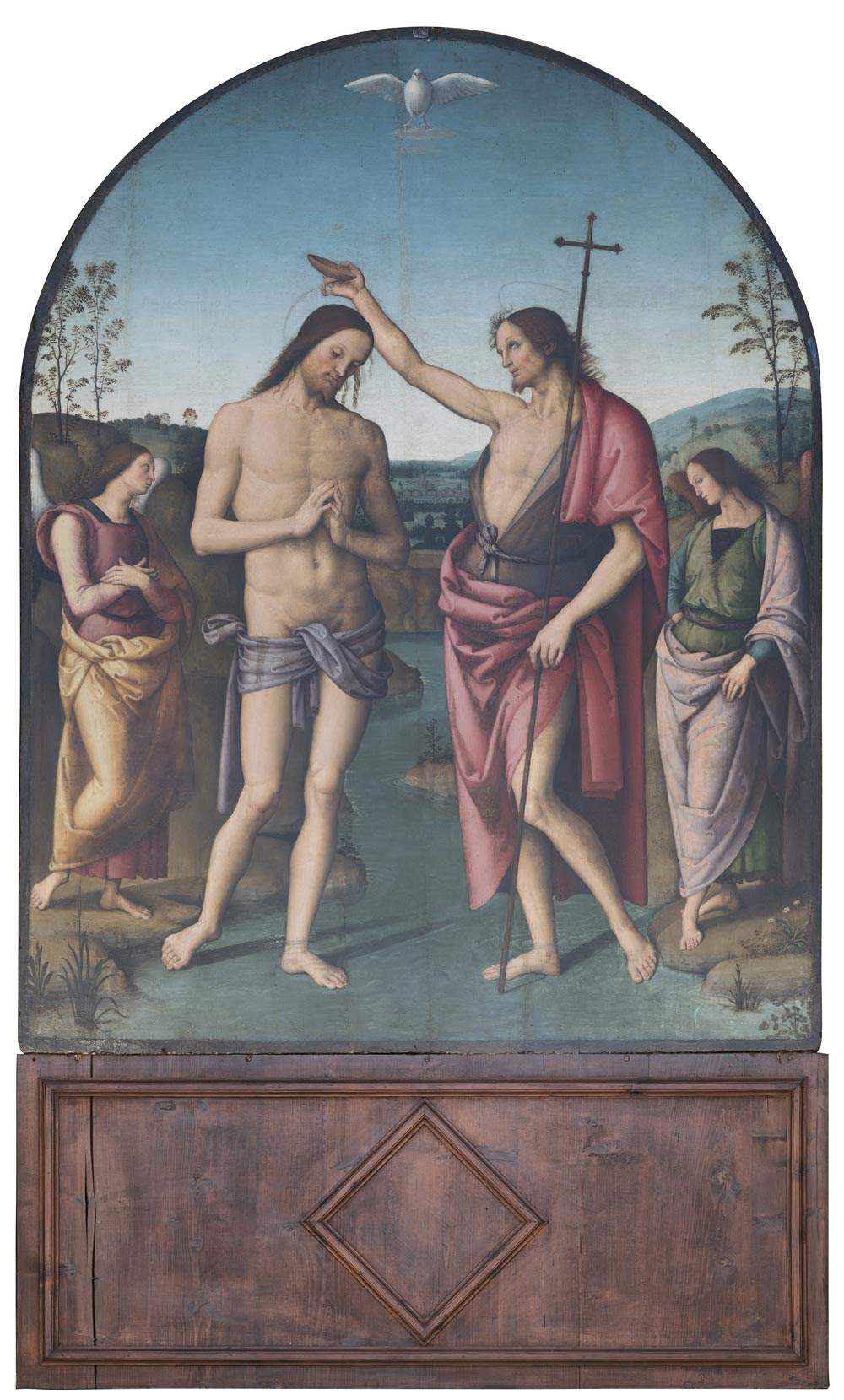
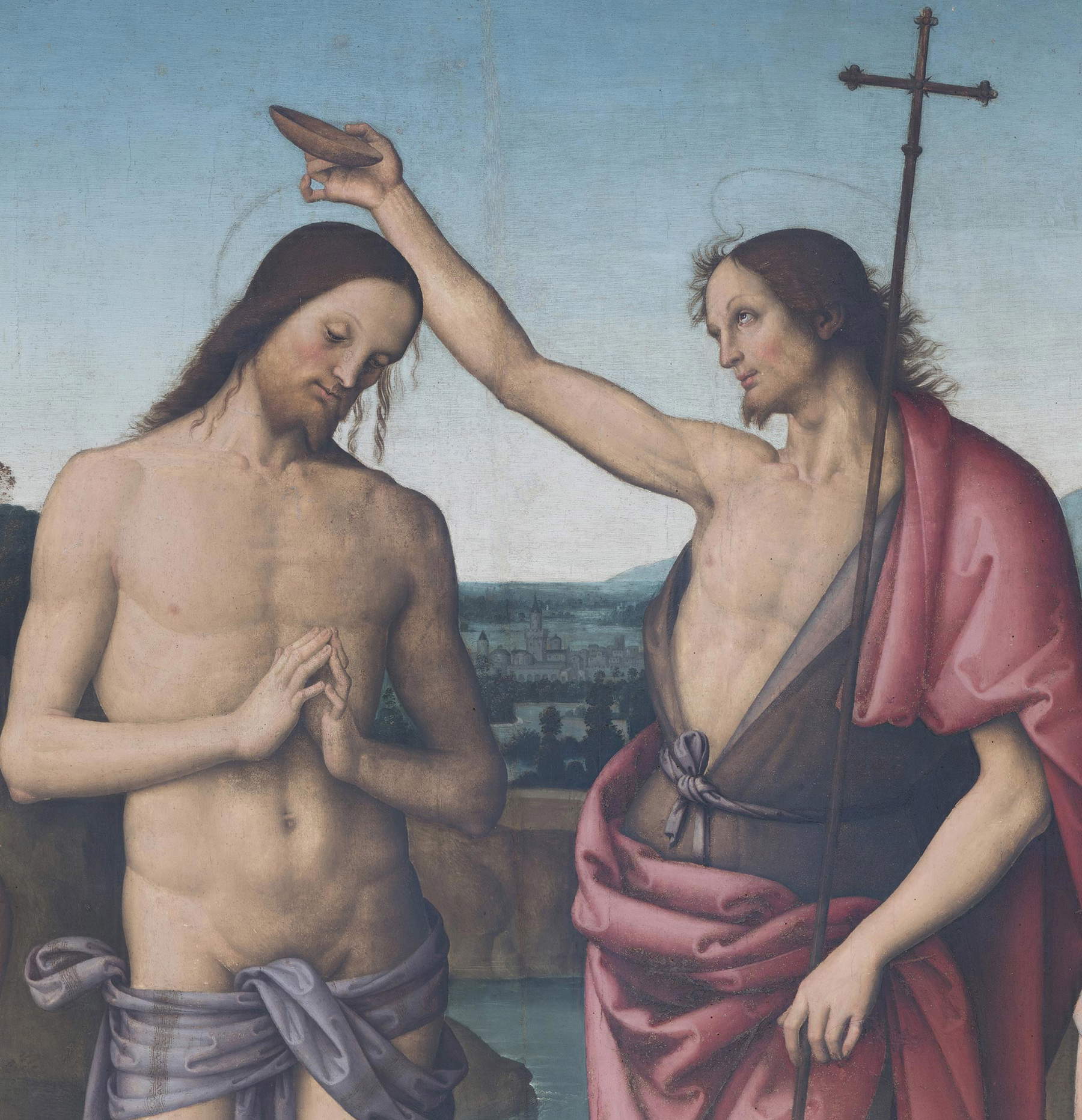
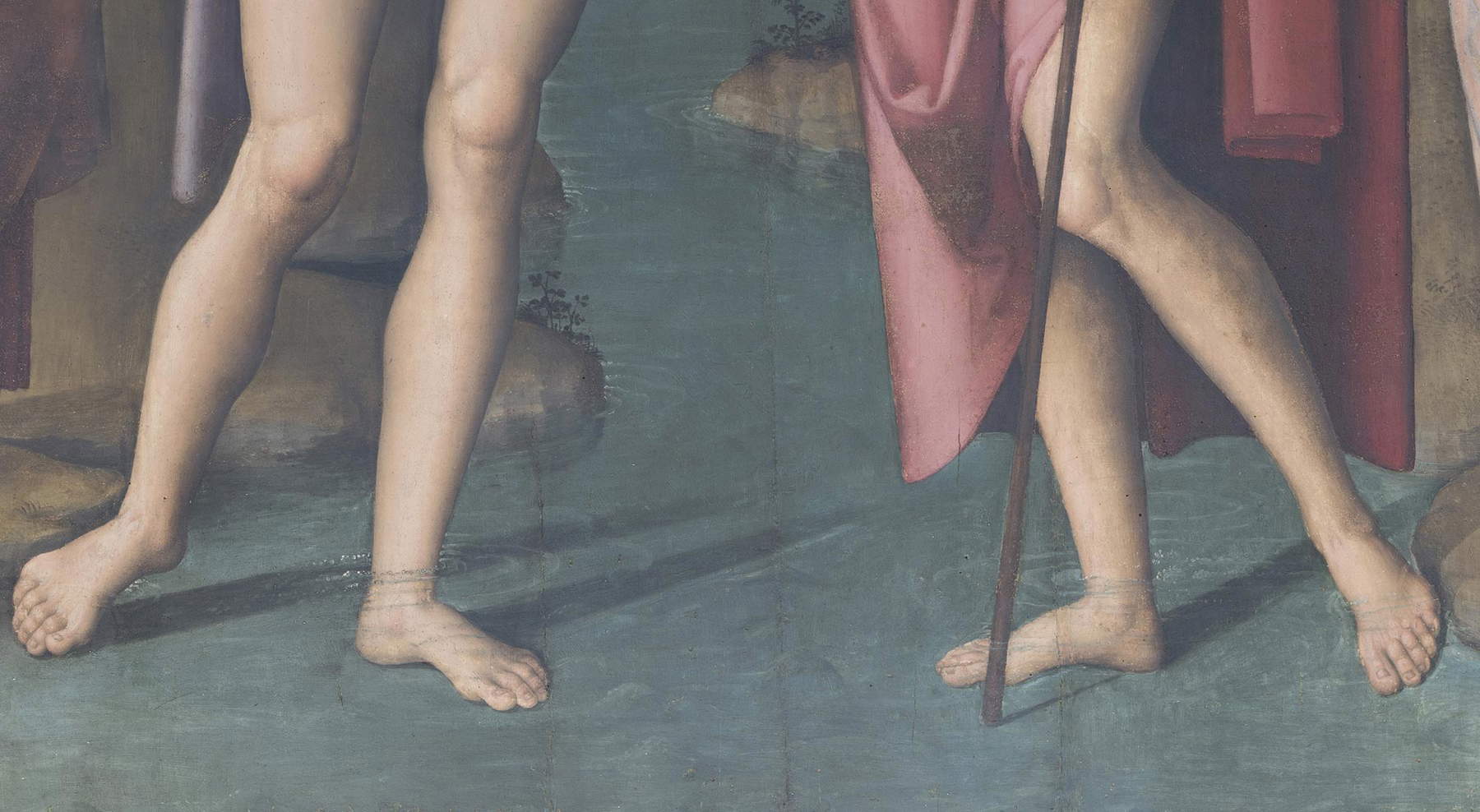




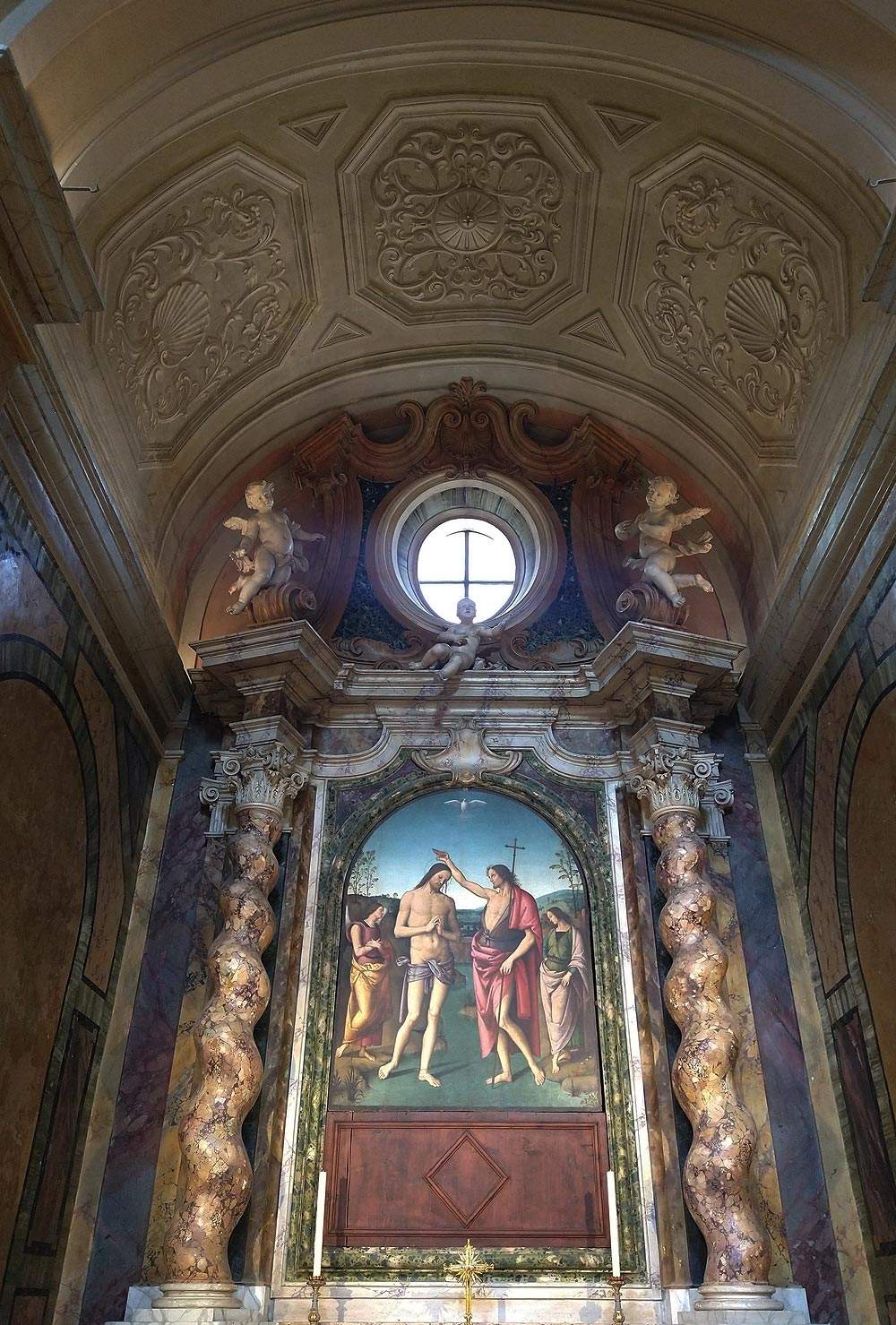
Jesus, on the left, holds his hands together and is clothed only in a cloth that covers his nakedness; he is looking down as he receives baptism, and a thin, almost imperceptible halo encircles his head. Unlike the latter, John the Baptist is almost completely covered with a robe that leaves half his chest bare, cinched at the waist by a knotted rope, and above a soft red cloth covers one shoulder and reaches down to his calves. With his left hand he holds a long, thin, astylar cross, while with his right hand he performs the important gesture, pouring water from a sort of bowl onto Christ’s head. The complexions, the elegance and plasticity of their poses combined with the perfect anatomy of the bodies, almost monumental and arranged according to the patterns of perspective, and the refinement of the faces hark back to the classical statuary of ancient Greece. At their sides, arranged symmetrically, are depicted two angels, also dressed in soft draperies that reach down to their ankles. Witnesses to the scene, both are depicted here in plastic and refined poses: one looks straight at him with his eyes to heaven and holds his hands crossed on his chest, the other turns his gaze downward, with a meditative air, and holds his hands one on his hip and the other on his thigh. The central figures, however, are painted at a larger size than the side angels, both to emphasize the importance of Christ and John the Baptist and the act that is taking place and to make the viewer realize that the angels are in a more backward position than the latter, who are instead in the very foreground. This perception of near and far is also emphasized in the landscape: here, what is placed in the foreground is rendered more sharply, while what is in the background or otherwise further away has blurrier outlines and less defined colors. An expedient that makes the whole setting more verisimilitude. It is also interesting to note how Perugino rendered the reflections of light in the water and sky, with particular highlights.
However, the landscape is typically Umbrian, characterized by rolling hills with slender-stemmed trees and neat foliage: almost stylized forms that make the landscape somewhat idealized. It is a natural landscape of green hills, trees, shrubs, streams, and a plain stretching to the horizon, brightened by a pale light under a clear blue sky. In the background, in the center, the outline of a city can also be glimpsed between the two protagonists.
The masterpiece appears harmonious in its entirety, both in terms of shapes and colors. Rounded, statuesque, slender and idealized forms are combined with pastel hues and light highlights: “una dolcezza ne’ colori unita che cominciò ad usare nelle cose sue” as Giorgio Vasari called it in his Lives, referring to Perugino.
The Baptism of Christ of Città della Pieve was completed in 1510 (it thus belongs to the last period of his production, what passed to critics as the most repetitive period of his career since he reused the same cartoons several times, followed the same models, but in reality they are works of sublime quality and great poetry). The monumental painting, according to the hypothesis formulated in 1931 by Fiorenzo Canuti, who identified the pievese panel with the one that a certain Nicola di Valente Porchetti ordered in his will (dated October 18, 1495), was displayed in the chapel of St. John the Baptist, located on the façade wall to the left of the main door and next to the baptismal font. It was around the year 1600 that the altarpiece was placed in the first chapel to the left of the side entrance, where it is currently located, when the ancient parish church of Saints Gervasius and Protasius was elevated to Cathedral status.

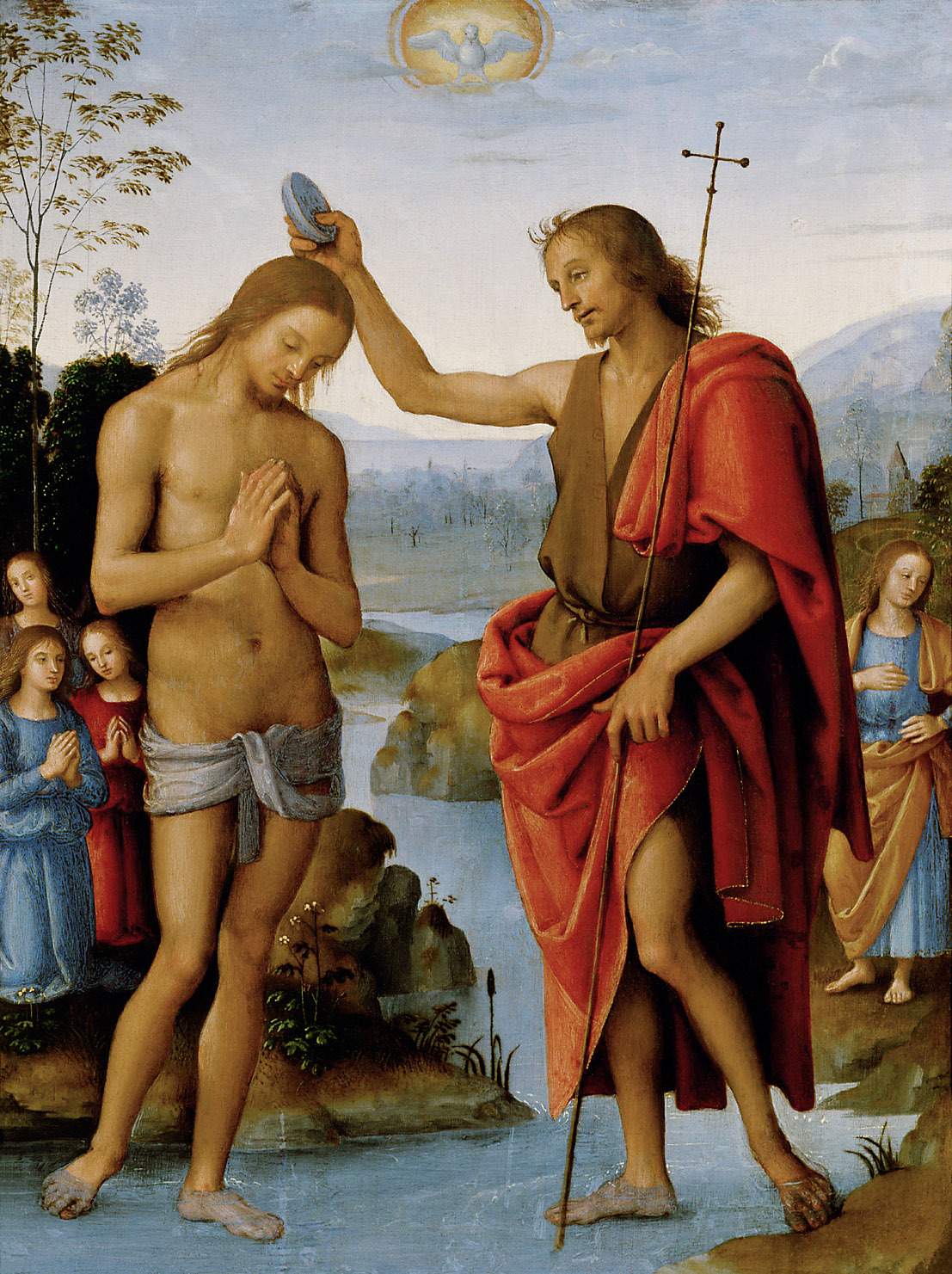 Perugino, Baptism
Perugino, Baptism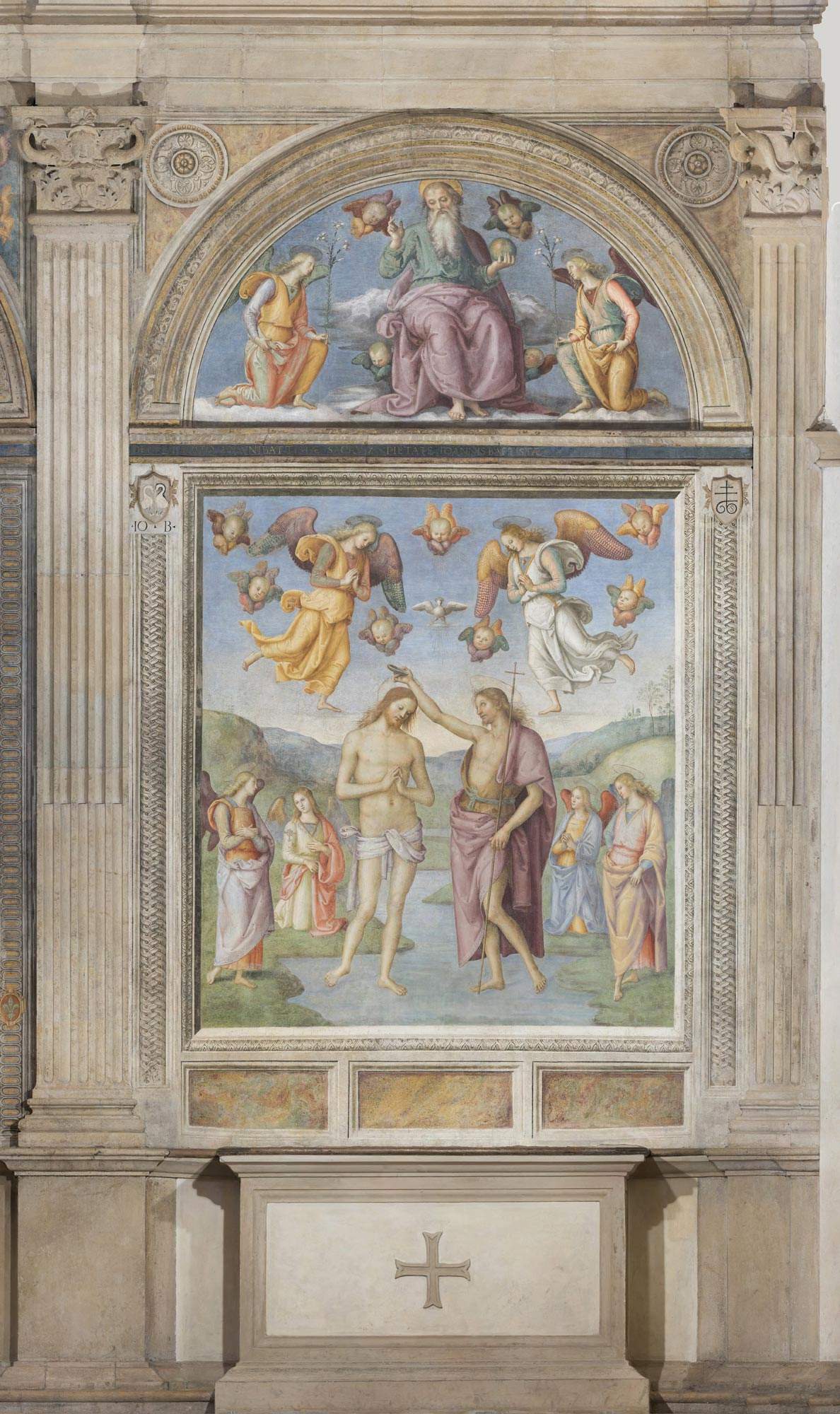
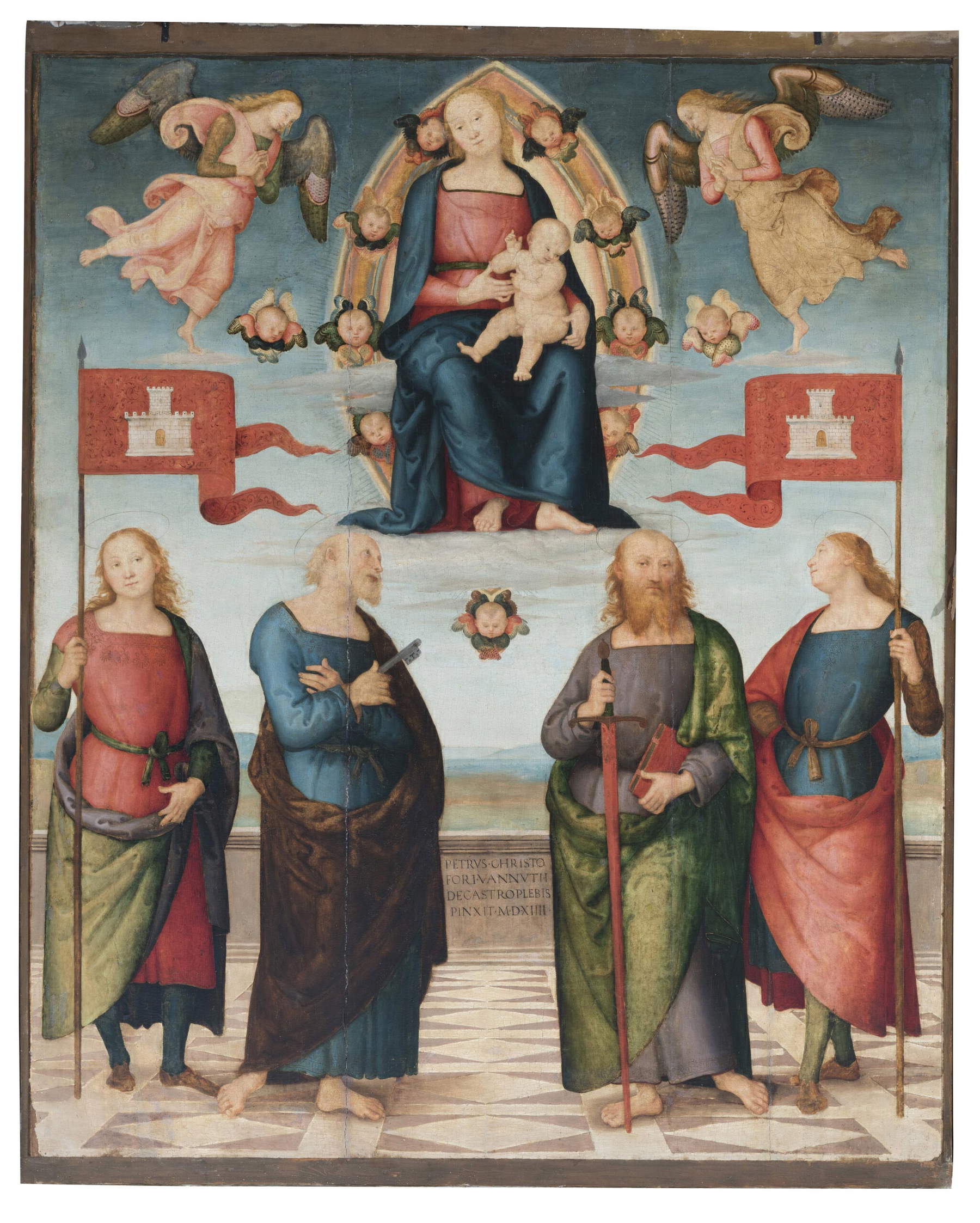
The composition with Christ and the Baptist in the center, feet bathed in the waters of the river, and other figures at the sides had already been used by Perugino in 1482 in the grandiose scene of the Baptism of Christ in the Sistine Chapel, much more populated and structured, with rocky heights, a walled city, and with God the Father in the sky within a nimbus of light surrounded by seraphim and cherubim and two angels in flight. More collected and intimate, as well as more similar to Città della Pieve’s Baptism of Christ, however, is the painting of the same subject now housed in the Kunsthistorisches Museum in Vienna: datable between 1498 and 1500, Christ and John the Baptist are also depicted here in the center of the work in poses identical to those in the painting mentioned above: feet immersed in water up to their ankles, one leg set further back than the other in front, Christ’s bowed head and clasped hands, covered only by a small cloth, and the Baptist pouring water over Jesus’ head. Immersed in a natural marshy landscape, three praying figures on one side, represented with smaller dimensions, and another behind John who looks off to the side apparently not participating in the scene, and is the only one with a halo around his head, witness the scene. Above, in the sky, flies the dove of the Holy Spirit. A similar composition is also found in the fresco of the altar of St. John the Baptist in the Oratory of the Nunziatella in Foligno, commissioned by Giovan Battista Merganti, as shown by the inscription below the lunette and the family coats of arms placed in the upper left corner. Attending the Baptism here are four angels, two praying and two kneeling, positioned on the banks of the river, and two angels in flight surrounded by cherubs.
The Città della Pieve work is, of those by Perugino that feature the same subject, the worst preserved, so much so that in the past it was even been assigned to his workshop (Umberto Gnoli, in 1923, assumed extensive collaboration by Giannicola di Paolo, while Ettore Camesasca, in 1959, considered it to be a workshop work tout court, although executed on a drawing by the master): it has been ascertained, however, following the 1962 restoration that brought to light the fineness of the drawing, that the hand of the master was behind this painting (so much so that Camesasca himself later accepted its autograph authorship). The painting also draws importance from the fact that it is one of the rare works by the artist still in his hometown. In addition, the Baptism of Christ is not the only work by Perugino inside the Cathedral of Città della Pieve: in the central part of the apse it is also possible to admire the Madonna and Child between Saints Gervasius and Protasius, who hold red banners with the symbol of the city, thus emphasizing their protection towards the entire citizenry, and Saints Peter and Paul. The work is dated 1514 and signed “Pietro Vannucci de castro plebis” on the parapet, highlighting its origins in Castel della Pieve, the ancient name of his native village.
The Cathedral of Saints Gervasius and Protasius thus constitutes an essential stop in getting to know the mature Perugino, who returns to his Città della Pieve, among the hills and landscapes he so loved and that serve as the backdrop for his masterpieces.
The article is written as part of “Pills of Perugino,” a project that is part of the initiatives for the dissemination and diffusion of knowledge of the figure and work of Perugino selected by the Promoting Committee of the celebrations for the fifth centenary of the death of the painter Pietro Vannucci known as “il Perugino,” established in 2022 by the Ministry of Culture. The project, edited by the editorial staff of Finestre Sull’Arte, is co-financed with funds made available to the Committee by the Ministry.
Warning: the translation into English of the original Italian article was created using automatic tools. We undertake to review all articles, but we do not guarantee the total absence of inaccuracies in the translation due to the program. You can find the original by clicking on the ITA button. If you find any mistake,please contact us.